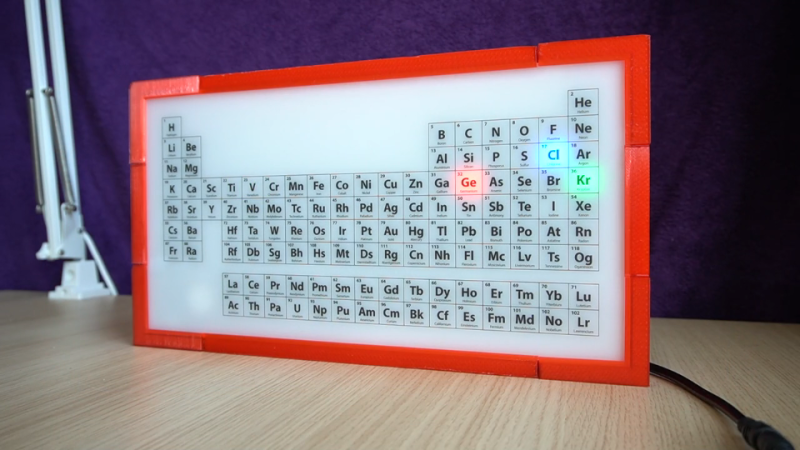We see a lot of clocks here at Hackaday, so many now that it’s hard to surprise us. After all, there are only so many ways to divide the day into intervals, as well as a finite supply of geeky and quirky ways to display the results, right?
That’s why this periodic table clock really caught our eye. [gocivici]’s idea is a simple one: light up three different elements with three different colors for hours, minutes, and seconds, and read off the time using the atomic number of the elements. So, if it’s 13:03:23, that would light up aluminum in blue, lithium in green, and vanadium in red. The periodic table was designed in Adobe Illustrator and UV printed on a sheet of translucent plastic by an advertising company that specializes in such things, but we’d imagine other methods could be used. The display is backed by light guides and a baseplate to hold the WS2812D addressable LEDs, and a DS1307 RTC module gives the Arduino Nano a sense of time. The 3D printed frame of the clock has buttons for setting the time and controlling the clock; the brief video below shows it going through its paces.
We really like the attention to detail [gocivici] showed here; that UV printing really gave some great results. And what’s not to like about the geekiness of this clock? Sure, it may not be as action-packed as a game of periodic table Battleship, but it would make a great conversation starter.
















Simple. Clean. Beautiful. Nerdy.
Perfect!
The only tweak I would recommend is to also put some sort of a color key on the clock which shows the correlation between the units of time and each color. I like this clock !
Ah, that common BGR colour order.
Briefly shown is another geeky display but more hidden. The display of the 2 letter code of the relevant element for the time in 3 spaces, to make it tougher leave the atomic number off. Cool, somebody build one!
None of the actinides or lower elements of the transition metals block will ever be illuminated though, nothing above Praseodymium.
Maybe days of the week? We’ve got Md for Monday (or Lu for Lundi), W, Th, Fr, Sm (Samedi), and Dy (Dimanche). I’m sure someone can come up wit something for Tuesday.
many years ago on this site I read an article which mentioned that pcb material is translucent to light, but it hadn’t found a use yet. This would be perfect, you could solder rgb leds on the rear of a pcb, while using traces in the shape of the elemental characters to cast a shadow.
Can it be purchased?